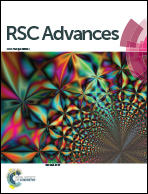Corundum type indium oxide nanostructures: ambient pressure synthesis from InOOH, and optical and photocatalytic properties†
Abstract
A simple, cost effective, surfactant free and scalable synthesis of rhombohedral In2O3 (rh-In2O3) nanostructures with controllable size and shape has been developed under ambient pressure by thermal dehydration of InOOH nanostructures. The InOOH nanostructures have been prepared by solvothermal reaction between indium nitrate hydrate with tetramethylammonium hydroxide (TMAH) in anhydrous methanol at 140 °C without any surfactant. The structure and morphology of the nanostructures have been characterized in detail by X-ray powder diffraction (XRD), Raman spectroscopy, and high-resolution transmission electron microscopy (HRTEM). The studies reveal that highly crystalline nanostructures of InOOH and rh-In2O3 with rice-grain type morphology are formed. The optical properties of the InOOH and rh-In2O3 nanostructures have been explored by UV-visible diffuse reflectance spectroscopy (UV-DRS) and room-temperature photoluminescence (PL) studies. The direct band gap of as-synthesized InOOH and rh-In2O3 nanostructures was estimated to be 3.75 and 2.95 eV, respectively, from the diffuse reflectance absorbance spectra. Both InOOH and rh-In2O3 nanostructures show intense blue emission under UV excitation which is attributed to the presence of oxygen vacancies. The thermal stability of the rh-In2O3 phase has been studied by differential scanning calorimetry (DSC), differential thermal analysis (DTA) and dilatometry of the as prepared sample. The potential of InOOH and rh-In2O3 nanostructures as photocatalytic materials for hydrogen generation from water/methanol (2 : 1) mixtures under UV/vis irradiation has also been evaluated for the first time.


 Please wait while we load your content...
Please wait while we load your content...